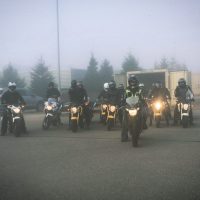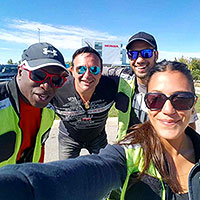No dilly-dally or jibber-jabber! Over the two training days, we 15 would-be motorcyclists focused on skills, skills, and skills.
That was how three instructors were able to pass us all through the M2 exam in 19 hours. Sheer, cruel, repetitive practice! Most exercises required low-speed operation for a few dozen metres at most. Then you’d ride round to the back of the line and repeat.
There was zero pleasure riding, no cooling reps around the periphery in third gear to counter the volcanic summer heat. Even the exercise that did entail gearing up to third, was quickly compounded with tasks, forcing us back to first in overly narrowed lanes we weren’t cross. But I digress.
 The first practical lesson was balancing and walking any of the variety of supplied motorcycles. Even this early in the day’s heat, even the tiny ones were heavy AF and sweaty work.
The first practical lesson was balancing and walking any of the variety of supplied motorcycles. Even this early in the day’s heat, even the tiny ones were heavy AF and sweaty work.
Next, we learned starting and stopping. Then starting and moving off, circling — “Keep your head up and looking where you WANT to go!” Jenn roared — then returning to the line before stopping again.
A machine that’s designed to go fast requires multiple concurrent skills to go slow.
Next, we practiced controlling the bike in stop-and-go traffic. “Anyone can ride a motorcycle fast,” said Vicki. “Riding slow is harder.” Consequently, we focused on slow.
Maintaining balance, releasing the clutch gently, balancing the back brake with the throttle is challenging. And compared to just cruising around the parking lot in circles, it’s functionally frustrating.
But the exam was in 14 hours. So, for the entire weekend, we rarely attained any breeze, just more skills.
SIPDE demands physical work and mental planning.
With some basics in the pocket, we began practicing defensive tactics — also executed deliberately slowly. We learned to ‘block’. Traffic is a constantly evolving set of circumstances; surviving is an ongoing puzzle. Meaning? Your lane (passing or curb?), riding conditions, and your next maneuver all factor where you position the bike.
For instance, if you’re waiting to turn right, you stop the bike diagonally from the left to the right ‘track’. Picture the lines you see in a car skid (a sobering vision for anyone astride a motorcycle). Those are the left and right tracks. Your position communicates your intention to turn right and ‘blocks’ them from going around you before you proceed.
But if you’re turning left from the left lane? You want to be in the left track and facing straightforward. If some ignorant asshole on his phone hits you from behind — it happens all the time — at least you’re thrusted forward, which is easier to recover from than if your handlebars were positioned to the left.
Such physical and mental skills were drilled again and again amid a positive atmosphere.
I think “This is one of the most fun things you’ll learn” was announced before every single new lesson. And we bought it. The point was to prevent us freaking out over the rapidly impending examination, by keeping our spirits up.
Mental, physical and spiritual: any experienced rider would agree that’s how it feels to control a motorcycle.


